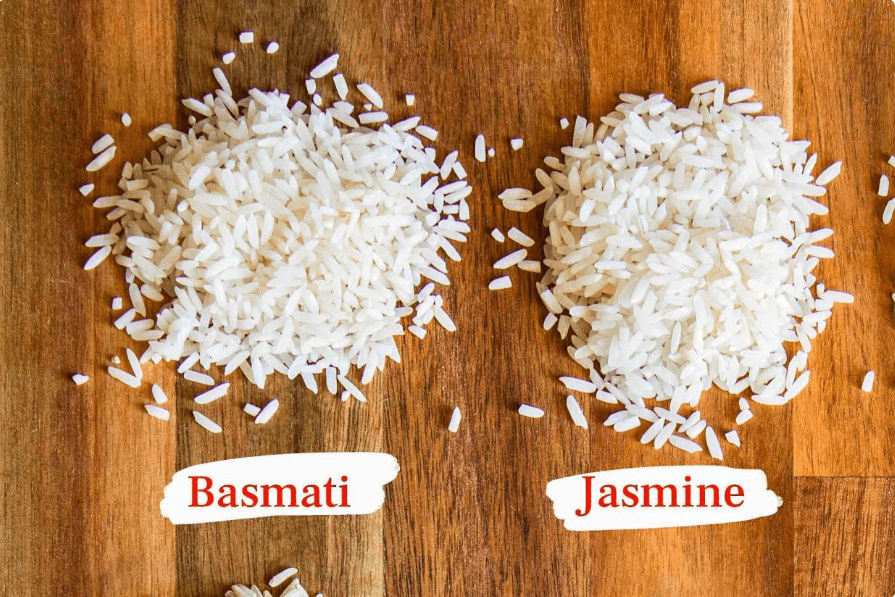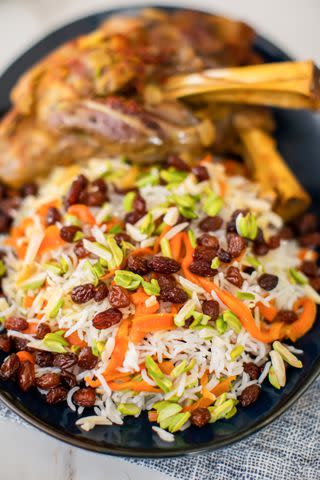Tags
Basmati Rice vs. Jasmine Rice: Experts Explain the Difference.
Chefs, cookbook authors, and Lundberg Family Farms weigh in.
Megan O. Steintrager

If you’re a fan of Indian, Thai, other South and Southeast Asian, and Middle Eastern cuisines, you’ve undoubtedly eaten basmati rice and jasmine rice. Both are wonderfully fragrant and often used as the base for myriad dishes, but could you use them interchangeably?
These two varieties of rice have key differences that influence when and how they’re eaten and to learn more, I consulted several experts, including fourth-generation rice farmer Brita Lundberg of Lundberg Family Farms, chef JJ Johnson, author of The Simple Art of Rice, and experts in Pakistani, Vietnamese, and Thai cuisines. Here’s what I learned.
The Difference Between Basmati Rice and Jasmine Rice
Johnson explains that both jasmine and basmati rice are aromatic long-grain Indica rice. They are different in many ways, including their origin, texture, aroma, and flavor.
Where the Rice Is Grown: “Jasmine rice originated in Thailand, while basmati rice was originally grown on the Indian subcontinent, primarily in India, Pakistan, Sri Lanka, and Nepal,” says Lundberg. “True basmati rice comes exclusively from certain regions of India and Pakistan,” Johnson adds. However, basmati varieties are now grown in places like California, where Lundberg is based, and in Texas, where it’s called Texmati.
Fast Facts
Although there are no official DOP- or DOC-style rules—designation of origin laws that prohibit naming certain products, like Champagne and Parmigiano Reggiano, unless they are grown in a specific location and produced in a specific way as determined by the rules—about labeling basmati rice in the United States, Lundberg says that the company labels its rice “California Basmati” because it is not grown in the Indian subcontinent. For a deeper dive into the issues around basmati provenance and labeling, check out this excellent article, Who Owns Basmati? by Priya Krishna, on The Kitchn.
Different Textures: While both jasmine and basmati rice are long-grain rice, they have different textures. “As a rule of thumb, length and texture are related,” Lundberg explains. “The shorter the rice, the stickier it will be when cooked, while long-grain varieties like basmati and jasmine rice tend to cook up light and separate.” Jasmine rice has a softer, stickier texture than basmati, which tends to be firmer and chewier.
“The main difference between jasmine and basmati is that the former has a higher level of amylopectin whereas the latter has a higher level of amylose,” explains Leela Punyaratabandhu, the author of several Thai cookbooks, including Simple Thai Food.
“And since amylopectin is a polysaccharide that contributes to stickiness and tenderness in rice, jasmine grains are softer and stickier when cooked than basmati.”
Different Aromas and Flavors: “Jasmine and basmati rice are both aromatic varieties known to fill the kitchen with their signature scents,” says Lundberg. “Jasmine rice tends to have a light, floral fragrance while basmati rice has a nutty, popcorn-like aroma.” She adds that jasmine rice has a slightly sweet, buttery flavor while basmati rice is known for its subtle nuttiness.
“One of the reasons for jasmine’s popularity (and what I like best about it) is the scent,” says Punyaratabandhu. “The aroma compound found in jasmine rice is the same compound found in pandan (pandanus) leaves, the so-called vanilla of Southeast Asia, which is the aroma that people in Thailand find exceedingly pleasing. That, plus the tenderness and the Goldilocks-level of stickiness—not too much, not too little—is why jasmine is so popular not only in Thailand but worldwide.”
How Jasmine and Basmati Rice Are Traditionally Served
Jasmine Rice: “Jasmine rice is used in Thai cuisine in the same way that other long-grain Thai rice varieties are used: as the main component of a meal and in various savory and sweet dishes that require long-grain rice,” Punyaratabandhu explains.
Jasmine is just one of many long-grain rice varieties used in Thai cooking. “It’s just that this one variety happens to be so popular domestically and internationally that it comes to represent what people think of when they think of Thai rice.”
While some people exclusively link jasmine rice to Thai food, it isn’t only served in Thai cooking. As an example, jasmine rice is one of many types of rice traditionally eaten with Vietnamese food. “Viet cooks use many kinds of rice for dishes but the default for everyday eating is jasmine,” says Andrea Nguyen, author of several Vietnamese cookbooks, including her latest, Ever-Green Vietnamese.
Basmati Rice: As much as jasmine rice is commonly linked to Thai food, basmati is linked to Indian food. However, basmati rice is a go-to in Pakistani, other South Asian, and many Middle Eastern cuisines. For example, Johnson notes that with its fluffy, individual grains, basmati is the preferred rice in Persian cuisine.
“Basmati rice is always a preferred rice in Pakistani cuisine because of its long grain and also the fact that it’s very fluffy and it also has the ability to really absorb flavor,” says Sumayya Usmani, author of several books, including Andaza: A Memoir of Food, Flavour and Freedom in the Pakistani Kitchen.
Basmati’s ability to absorb flavor makes it wonderful for dishes like pulao in which the rice is cooked in a flavorful stock, Usmani explains. It’s also a go-to for biryani in both Indian and Pakistani cuisine, where you want the rice to become infused with flavor and cook in a beautiful, fluffy way, not in a “stodgy, sticky way,” as Usmani describes.
Basmati’s ability to absorb flavor makes it wonderful for dishes like pulao in which the rice is cooked in a flavorful stock, Usmani explains. It’s also a go-to for biryani in both Indian and Pakistani cuisine, where you want the rice to become infused with flavor and cook in a beautiful, fluffy way, not in a “stodgy, sticky way,” as Usmani describes.

Can You Substitute Jasmine for Basmati and Vice Versa?
Since both jasmine and basmati rice can be found at many grocery stores, we recommend you go with what the recipe calls for, since chances are high that the recipe developer called for that particular rice for a good reason.
“I would say in cases where your culture- and tradition-informed habits and preferences play the biggest role (like how people typically eat a Thai curry with jasmine or an Indian curry with basmati), it’s up to the individual,” says Punyaratabandhu.
“However, in dishes that are associated with a specific rice texture, subbing one for the other is likely to lead to unfavorable results. For example, you won’t get the familiar, soft, velvety texture you expect in Thai rice porridge from basmati. Likewise, using jasmine to make Indian biryani will turn the dish stickier than usual.”
Usmani is also hesitant to suggest substituting jasmine for basmati. “I don’t think that it’s that easy to substitute rice, though you can do it in a hurry for everyday convenience,” she says. “But really it’s very much about staying true to the cuisine if you are really trying to cook something that’s from there.”
The Takeaway
Jasmine and basmati rice are two types of aromatic long-grain rice. Jasmine has a more floral fragrance and slightly sweet flavor, while basmati has a nutty flavor and aroma. Jasmine is also slightly softer and stickier than basmati rice. Use the rice recommended in the recipe unless you feel confident that rice with a different texture or aroma than the one called for will go well with the dish.
Published Date: January 9, 2025






